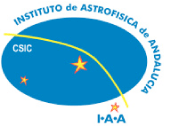Water vapour detection in HD 209458 b with CARMENES
 We find a cross-correlation signal with a S/N ratio of 6.4, revealing H2O in HD 209458 b. We obtain a net blue-shift of the signal of –5.2 (-1.3,+2.6) km s−1 which, despite the large error bars, is a firm indication of day- to night-side winds at the terminator of this hot Jupiter. Additionally, we performed a multi-band study for the detection of H2O individually from the three near infrared bands covered by CARMENES. We detect H2O from its 0.96–1.06 μm band individually with a S/N of 5.8, and also find hints of a detection from the 1.06–1.26 μm band, with a low S/N of 2.8. No clear planetary signal is found, from the 1.26–1.62 μm band.
We find a cross-correlation signal with a S/N ratio of 6.4, revealing H2O in HD 209458 b. We obtain a net blue-shift of the signal of –5.2 (-1.3,+2.6) km s−1 which, despite the large error bars, is a firm indication of day- to night-side winds at the terminator of this hot Jupiter. Additionally, we performed a multi-band study for the detection of H2O individually from the three near infrared bands covered by CARMENES. We detect H2O from its 0.96–1.06 μm band individually with a S/N of 5.8, and also find hints of a detection from the 1.06–1.26 μm band, with a low S/N of 2.8. No clear planetary signal is found, from the 1.26–1.62 μm band.
Our significant H2O signal at 0.96–1.06 μm in HD 209458 b represents the first detection of H2O from this band individually, the bluest one to date. The unfavorable observational conditions might be the reason for the inconclusive detection from the stronger 1.15 and 1.4 μm bands. H2O is detected from the 0.96–1.06 μm band in HD 209458b, but hardly in HD 189733b, which supports a stronger aerosol extinction in the latter, in line with previous studies. Future data gathered at more stable conditions and with larger S/N at both optical and near-infrared wavelengths could help to characterise the presence of aerosols in HD 209458 b and other planets.



